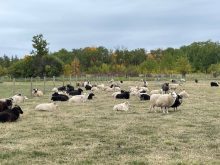Why do we recommend crop rotations in temperate climates? As you may know, many crops like sugar cane can be grown for two to three years and even up to 10 harvests. Alfalfa crops last five to 10 years. In the southern Prairies, the standard crop rotation used to be wheat, fallow, wheat. Now with the aid of pesticides, particularly herbicides, such land can be continuously cropped provided soil moisture is not a limiting factor.
In long ago western Europe, most crop rotations were for three or four years. These rotations were primarily with small grains and legumes. Fertilizers a few hundred years ago were virtually non-existent except for livestock manure and slaked limestone. The limestone was used to bring acidic soils often at pH 4.5 or even lower into better crop production at around pH 6.
Read Also

Claas brings 1000 Series SP forage harvesters to Canada
In mid-August, Claas unveiled its new line of Jaguar forage harvesters at an event in Visalia, California, deep in the heart of that state’s dairy region.
The role of legumes, usually a clover of some kind or alfalfa, was to fix nitrogen for subsequent crops and to provide more nutritious livestock feed. Peas and fava beans were also used for nitrogen fixation but usually on a smaller scale.
The European croplands as well as vast crop-growing areas of Asia have remained productive for thousands of years. They have not collapsed or vanished as some would have us believe.
Remember, the world’s croplands are vast growing areas fed with nutrients and water to feed the world. Some major crops of tomatoes, peppers, cucumbers and lettuce greens are also grown in greenhouses and so on, using just oxygenated, nutrient-balanced water totally in the absence of any soil, but it’s hardly of world food consequence.
Why do agronomists keep recommending crop rotation as a best management practice for cropland soils and grain yield enhancement? One could argue that, technically, it’s possible to grow continuous spring wheat, barley or canola, and with today’s pesticide “tool kits” you could just about control or eliminate all weeds, diseases and insect pests. What are the consequences, if any, of growing the same crop year after year on the same land?
The consequences
Crop rotations in the past were done to control weeds, build up nitrogen fertility and to prevent insect pests and plant diseases. In my many years travelling around Western Canada, I have seen continuous canola and wheat many times in the central Prairies, but no big deal and no ruination of the cropland, just yields for both crops generally below their potential. Crop rotation is not the Holy Grail, but it is the best way to fully utilize cropland yield capabilities.
Back in the 1980s and ’90s, I initiated the Blackleg of Canola Control Program. We had Westar, an Argentine canola (Brassica napus) that was an outstanding yield producer. Canola bushel prices were good back then but Westar was highly susceptible to a new virulent strain of blackleg. The disease was already established in Saskatchewan and Manitoba and to help prevent it from establishing in Alberta, it was mandated that all canola seed had to be tested and shown to be free of the virulent blackleg. Canola growers were also asked to follow a three-year rotation, not the usual wheat-canola-wheat-canola system, to help keep virulent blackleg from taking hold in Alberta.
Canola growers were fastidious about canola seed testing. On the other hand, aerial photographs obtained from Alberta’s agricultural field staff showed that in several of our provincial county areas some 60 to 70 per cent of the fields in several areas showed up yellow. Not much to figure that out.
Anyway, the canola seed testing program bought time before the advent of new blackleg-resistant canola varieties. The program at the time, some 35 years ago, was estimated to have saved growers half a billion dollars and more from potential yield losses.
Dead cow units
In order to get growers to seriously think about destructive plant diseases, I used to class the diseases as dead cow units. I initiated this after seeing some front page pictures in a Lloydminster newspaper showing a couple of cows that had died from bloat in an alfalfa pasture. The cow deaths were looked upon as a major financial loss amounting to $1,000 per cow.
A field of canola that had just been inspected near Cut Knife, Sask., had about a 60 to 70 per cent yield loss due to blackleg infection. Growers seemed to shrug this off when I reported that at a talk I gave at the time. I estimated the field had a yield potential of around 30 bushels. A 60 per cent loss of a 30-bushel yield works out to 18 bushels an acre, and at $9 per bushel that’s $162 an acre. In a 150-acre quarter, the grower losses are $24,300. That’s a loss of 24 cows.
It seemed back then that Prairie farmers had difficulty understanding crop diseases. Farmers could understand weed problems and were quick to react to insect problems, but they were generally hazy about disease problems. They seemed to accept disease as inevitable and not a preventable issue.
Now, in the case of highly destructive diseases in the Canadian Prairies such as clubroot in canola and aphanomyces root rot in peas, which are both soil-borne, crop rotation becomes essential. The greater the yield expectations from higher crop inputs and smaller profit margins, the greater the economic importance of crop rotations.
The Prairie potato crop is a sterling example. The Prairie provinces now produce more than 50 per cent of Canada’s potato crop. Potato yields in the 1970s were around six to eight tons per acre. Now, even on fallowed dryland, potato yields range from 15 to 18 tons per acre and up to 25 tons per acre under irrigation.
New potato seed is planted virtually every year, with growers utilizing four- to five-year crop rotations along with effective herbicides, fungicides and insecticides and balanced nutrients for optimum yields. All this with the exact same variety of potato — the Netted Gem (other names are Russet Burbank, Idaho Baker, russets, it’s all the same potato).
Producers now have to realize if their cropland is infested with clubroot of canola or aphanomyces of peas let alone other diseases, they have to resort to at least some rotation or face crop yield disasters. We have resistance with clubroot of canola but after three to four canola crops that resistance fails and crop yields plummet. As for peas, there are no current resistant pea varieties for aphanomyces and, in fact, this disease is also very destructive to lentils.
Cereals so far are relatively free of destructive soil-borne diseases since take-all of wheat has been wiped out, but there are specific cyst nematodes just south of the border in the United States that can be very destructive on all small grain cereals.
Crop rotation should go hand in hand with disease prevention. Destructive soil-borne diseases are just that — they are brought onto your cropland on the wheels of crop equipment and grain and hay trucks. Be aware of these diseases in your neighbourhood. I am still mystified as to why only 60 per cent of canola growers are using clubroot-resistant varieties. The other 40 per cent who are not using resistant varieties may be playing Russian roulette with their future canola crop incomes.
When fruit is rotten it cannot ripen again.
















